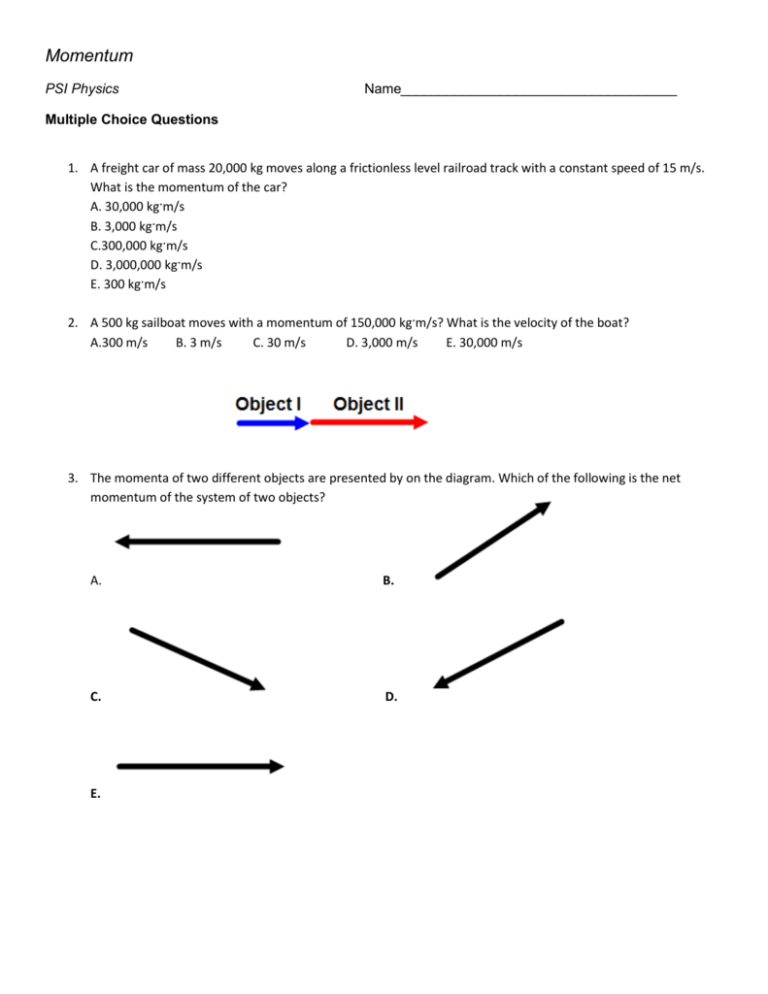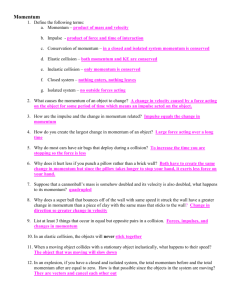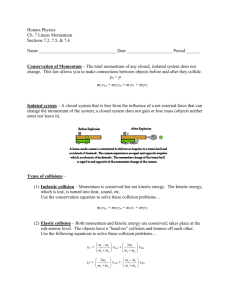Multiple Choice
advertisement

Momentum PSI Physics Name____________________________________ Multiple Choice Questions 1. A freight car of mass 20,000 kg moves along a frictionless level railroad track with a constant speed of 15 m/s. What is the momentum of the car? A. 30,000 kg·m/s B. 3,000 kg·m/s C.300,000 kg·m/s D. 3,000,000 kg·m/s E. 300 kg·m/s 2. A 500 kg sailboat moves with a momentum of 150,000 kg·m/s? What is the velocity of the boat? A.300 m/s B. 3 m/s C. 30 m/s D. 3,000 m/s E. 30,000 m/s 3. The momenta of two different objects are presented by on the diagram. Which of the following is the net momentum of the system of two objects? A. B. C. D. E. 4. The momenta of two different objects are presented by on the diagram. Which of the following is the net momentum of the system of two objects? A. B. C. D. E. 5. A cannon fires a cannonball and recoils backward. Which of the following statements is true about the cannon recoil? A. It happens because the energy of the system is conserved B. It happens because the energy of the system is increased C. It happens because the momentum of the system is not conserved D. It happens because the momentum of the system is conserved E. It happens because the momentum of the system is increased 6. An air balloon hovers at a certain altitude above the ground. A pilot throws a sand bag down from the balloon. What is the direction of the balloon’s velocity just after the bag was thrown? A. B. C. D. E. 7. What is the momentum of the cannon after firing a cannon ball with an initial momentum of 5,000 kg·m/s to the right? A. 5,000 kg·m/s to the right D. 2,500 kg·m/s to the right B. 5,000 kg·m/s to the left E. 2,500 kg·m/s to the left C. zero 8. A platform moves at a constant velocity on a horizontal surface. What happens to the velocity of the platform after a sudden rain falls down? A. It increases because the energy is conserved B. It decreases because the energy is conserved C. It remains constant because the momentum is conserved D. It increases because the momentum is conserved E. It decreases because the momentum is conserved 9. A stationary skateboarder I with a mass of 50 kg pushes a stationary skateboarder II with a mass of 75 kg. After the push the skateboarder II moves with a velocity of 2 m/s to the right. What is the velocity of the skateboarder I? A. 3 m/s to the left B. 2 m/s to the left C. 1 m/s to the right D. 3 m/s to the right E. 2 m/s to the right 10. A loaded freight car A with a mass of 24,000 kg moves at a constant velocity of 8 m/s on a horizontal railroad track and collides with an empty stationary car B with a mass of 8,000 kg. After the collision the cars stick to each other and moves like one object. What is the velocity of two cars after the collision? A. 2 m/s B. 4 m/s C. 6 m/s D. 8 m/s D. 12 m/s 11. A 40 kg skateboarder runs at a constant velocity of 12 m/s and jumps of a stationary skateboard with a mass of 8 kg. What is the velocity of the skateboard after the jump? A. 12 m/s B. 90 m/s C. 60 m/s D. 20 m/s E. 10 m/s 12. An 80 kg diver jumps off a moving boat. The boat has a mass of 400 kg and moves at a constant velocity of 2 m/s. What is the velocity of the boat after the jump if the diver jumps with a velocity of 3 m/s in opposite direction to the initial velocity of the boat? A. 2 m/s B. 3 m/s C. 4 m/s D. 5 m/s E. 6 m/s 13. Block A with a mass 2m moves on a frictionless horizontal surface at a constant speed v and collides inelastically with B of mass m. What is the velocity of two blocks after the collision? A. v 1 1 B. 2v 2 C. 3v 1 D. 3v E.4 v 14. Block A with a mass m moves on a frictionless horizontal surface at a constant velocity v and collides elastically with an identical block B. What is the velocity of block A after the collision? A. 0 m/s B. v 1 C.2 v 1 D. 3v 2 E. 3v 15. Block A with a mass m moves on a frictionless horizontal surface at a constant velocity v and collides elastically with an identical block B. What is the velocity of block B after the collision? A. 0 m/s B. v 1 2 C. v 1 3 D. v 2 3 E. v 16. A 10 kg object moves at a constant velocity 2 m/s to the right and collides with a 4 kg object moving at a velocity 5 m/s to the left. Which of the following statements is correct? A. The total momentum before and after the collision is 20 kg·m/s B. The total momentum before and after the collision is 40 kg·m/s C. The total momentum before and after the collision is 10 kg·m/s D. The total momentum before and after the collision is 30 kg·m/s E. The total momentum before and after the collision is zero 17. When two objects collide elastically the momentum is conserved. Which of the following is true about the kinetic energy during the collision? A. The kinetic energy is conserved B. The kinetic energy is lost C. The kinetic energy is gained D. The kinetic energy completely transforms into thermal energy E. More information is required 18. When two objects collide inelastically the momentum is conserved. Which of the following is true about the kinetic energy during the collision? A. The kinetic energy is conserved B. The kinetic energy is not conserved C. The kinetic energy is gained D. The kinetic energy completely transforms into thermal energy E. More information is required 19. A light beach ball moving with a velocity 2 m/s to the right collides elastically with a stationary bowling ball. After the collision the bowling ball remains stationary. What is the velocity of the beach ball after the collision? A. 0 m/s B. 2 m/s to the left C. 4 m/s to the left D. 3 m/s to the left E. 1 m/s to the left 20. A bowling ball moving with a constant speed v collides elastically with a stationary beach ball. After the collision the bowling ball barely slows down. What is an approximate speed of the beach ball after the collision? A. v 1 B. 2v 1 C. 3v D. 2v E. 3v 21. A big truck collides inelastically with a small car. Which of the following statements is true? A. The truck experiences the greater magnitude of impulse during the collision B. The car experiences the greater magnitude of impulse during the collision C. They experience the same magnitude of impulse during the collision D. The impulse of each object is zero during the collision E. More information is required 22. A tennis ball approaches a racket with a momentum of 5 kg·m/s and bounces back with a momentum of 6 kg·m/s after the collision with the racket. What is the change in momentum of the tennis ball? A. 1 kg·m/s B. 5 kg·m/s C. 6 kg·m/s D. 11 kg·m/s E. 0 kg·m/s 23. A rubber ball moving with an initial momentum Pi collides elastically with a vertical wall. Which of the following is correct about the vector of impulse that the ball experiences during the collision? A. B. C. D. E. 24. A piece of clay moving with an initial momentum Pi collides with a vertical wall and sticks to it. Which of the following is correct about the vector of impulse that the clay experiences during the collision? A. B. C. 25. The force as a function of time is presented by the graph. What is the impulse exerted on the object during first six seconds? A. 40 N·s B. 80 N·s C. 120 N·s D. 240 N·s E. 360 N·s D. E. ANSWERS 1. C 2. A 3. E 4. A 5. D 6. E 7. B 8. E 9. A 10. C 11. E 12. B 13. D 14. A 15. B 16. E 17. A 18. B 19. B 20. D 21. C 22. D 23. A 24. A 25. D








